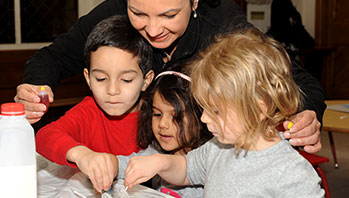- different open containers such as flower pots, plastic pots, empty paint buckets, small yogurt containers
- rubber bands of different thicknesses and lengths
- children's rubber band guitars (from earlier in the week)
- pitch
- pluck
- volume
MA Standards:
English Language Arts/Speaking and Listening/SL.PK.MA.1 Participate in collaborative conversations with diverse partners during daily routines and play.
MA Draft STE Standards:
Physical Sciences/Energy and PS4.B Apply their understanding in their play of how to change volume and pitch of some sounds.
Head Start Outcomes:
Logic and Reasoning/Reasoning and Problem Solving Recognizes cause and effect relationships.
Logic and Reasoning/Reasoning and Problem Solving Classifies, compares, and contrasts objects, events, and experiences.
PreK Learning Guidelines:
Science and Technology/Technology and Engineering 23 Explore and describe a wide variety of natural and man-made materials through sensory experiences.
Small Group: New Rubber Band Guitar

© Commonwealth of Massachusetts, Department of Early Education and Care (Jennifer Waddell photographer). All rights reserved.
STEM Key Concepts: An action has to happen to make a sound, Sounds vary in pitch
ELA Focus Skills: Active Listening, Vocabulary
Have children join you in making rubber band guitars by placing rubber bands around materials such as flower pots, plastic pots, empty paint buckets, and small yogurt containers (these should be different materials from those used earlier in the week).
As children explore making sounds with the rubber bands, talk about what you are hearing and wondering. Say, I hear a lot of different sounds from the guitar. Let’s try plucking these two rubber bands. Ask,
- What is different about the two sounds? What is the same?
- Can you describe In pitch of each sound? The volume?
Reflect and Share
Have children play their rubber band guitars and then their new guitars to compare the sounds the guitars make. Ask them to talk about any differences in sound, and offer explanations for why the sounds are different.
